The renowned optical instrument firm of Ernst Leitz of Wetzlar in Germany produced the first modern camera in 1925, the Leica 1 Model A. Designed by two brilliant engineers, Oskar Barnack and Max Berek, it revolutionised photography by using 35mm cine film combined with outstanding optics in a pocket-sized camera. By the end of the ’20s over 21,000 had been sold, and enthusiastic customers such as Alexander Rodchenko, André Kertész and Paul Wolff were changing the way photographs were taken. Candid street photography became possible as you no longer had to lug around heavy plate cameras and tripods to get good quality photographs. Kodak roll film cameras had a huge impact on amateur photography from the end of the 19th Century but the quality of the images was poor and serious photographers still preferred using plates until the Leica came along.
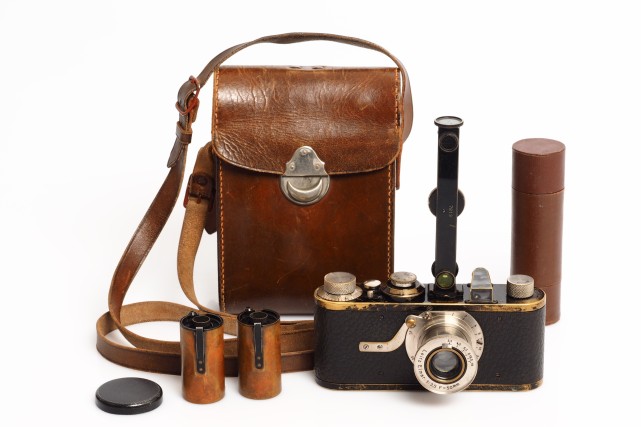
A disadvantage of the Model A was that it came with a fixed 50mm lens and so Leitz answered the growing demand for different focal lengths by coming up with the Model C in 1930 which was fitted with a flange so that screw-in lenses could be used. The previous Model B was the Compur Leica which had a leaf shutter within the fixed lens.
Because the alloy bodies were not all identical the flange to film plane distance on the first few thousand cameras was individually adjusted. The lenses were matched to each body and part of the camera number was engraved on the lens. There was a small ‘peep hole’ for focusing at the back of the camera body so that Leitz technicians could make final minute adjustments to the lens flange.
The obvious problem with this was that you had to buy a matching set of expensive lenses when you bought the camera. After around 3000 cameras had been produced the flange to film distance was set at exactly 28.8mm and lenses were truly interchangeable. The flanges and lenses were marked with a numeral ‘0’ to signify the change. Many of the ‘non-standard’ Model Cs were converted to the standard type by the factory and original ones, especially with a set of matching lenses, are very rare indeed.
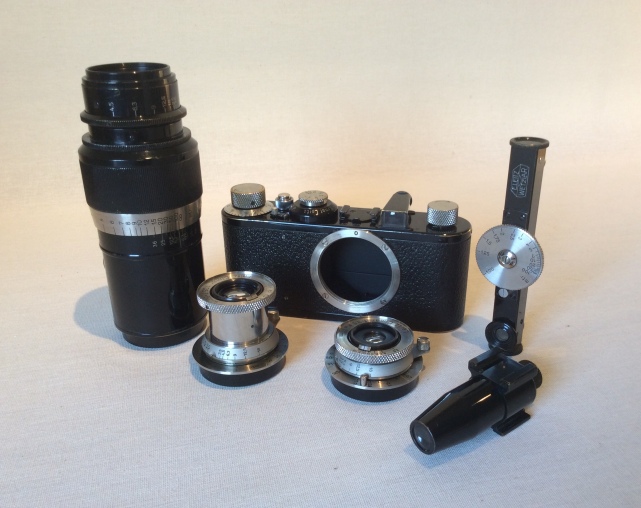
The first available lenses were the standard f3.5 50mm lens, a f3.5 35mm wide angle lens, a telephoto f4.5 135mm, all called Elmar*, and a faster 50mm lens, the f2.5 Hektor (named after Berek’s dog!). The image above shows the telephoto, standard and wide angle lenses, with a FOFER range-finder, and VISIL torpedo view-finder. Note the small ‘0’ at 12 o’clock on the camera body lens flange signifying that this is the standard Model C. All this kit would have cost you the equivalent of £2,500 in today’s money, a lot cheaper than a modern Leica!
*Elmar = a combination of the letters in Ernst Leitz and Max Berek – it replaced the more obvious Elmax name of the previous version due to a patent claim by a rival optical company.
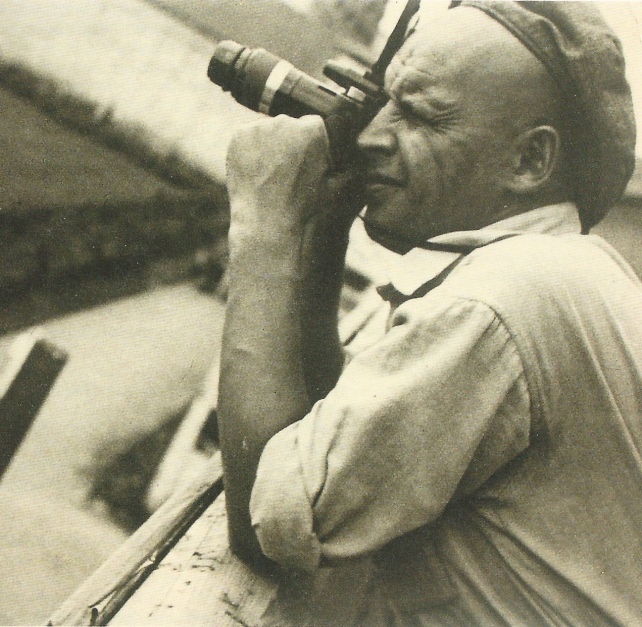
The great Soviet artist and photographer Alexander Rodchenko using a Leica 1(C) with an Elmar 135mm telephoto lens and FOFER range-finder clipped to a ‘torpedo’ view-finder [photograph by A Skurikhin, 1933]
Right from the start of production the Leica was available with a range of accessories. Barnack was convinced that Leitz must have an influence over the whole photographic process to ensure that photographs from the camera were top quality. Film cassettes, range and view-finders, enlargers and developing tanks were offered, and by 1931 the Leica catalogue ran to nearly 100 pages. These examples show some of the huge range of accessories on offer:
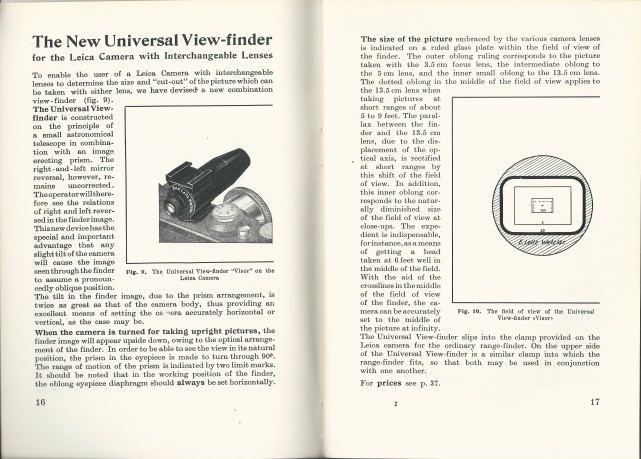
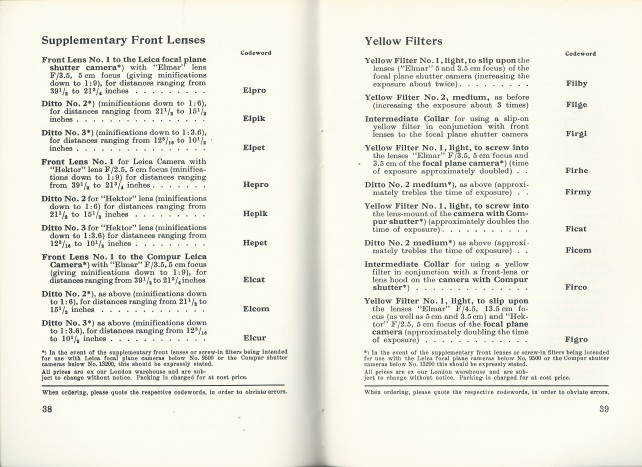
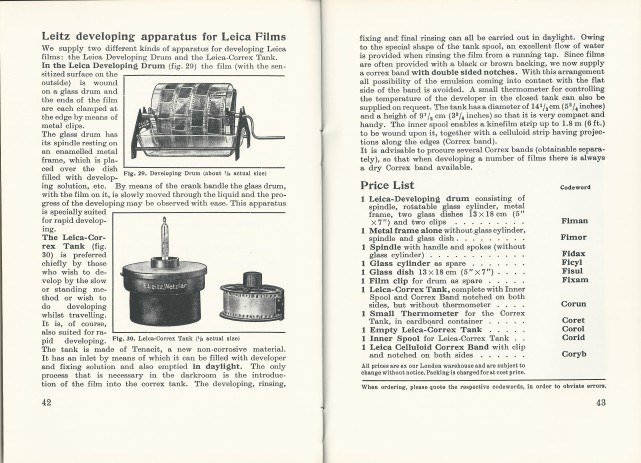
Below is a small selection from the catalogue (apart from the 1933 ELDUR glass slide contact printer at the back). There are various yellow and UV filters with a leather filter purse, close-up lenses, a developing tank with thermometer, film winding and trimming devices, and an ELDIA contact printer. The small black device by the leather case is a WINKO right angle view-finder. Two film cassettes are shown by a rare twin cardboard container. Modern 35mm film cassettes were based on these and will fit the early Leicas!
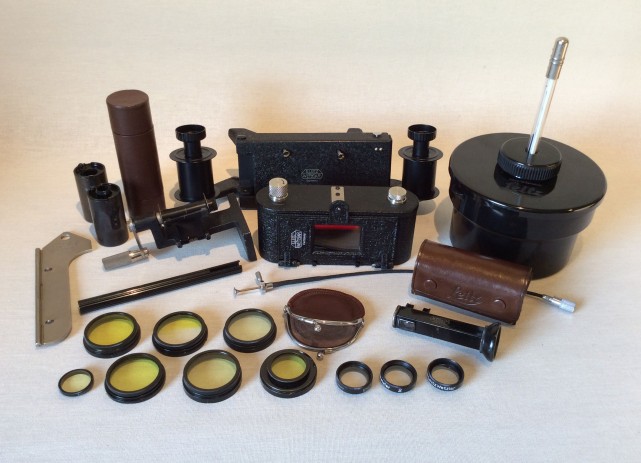
The unique Leitz reference code for each product is shown in the catalogue against each item. Leica aficionados are familiar with the quirky, and sometimes unintentionally amusing, five letter codes that Ernst Leitz provided for everything that they sold, from cameras and binoculars to darkroom accessories and rolls of gummed paper. In fact this was quite common for manufacturers since the start of the telegraph. You generally paid by the word for a telegram so asking Leitz to send another 6 “Extra long arms for attaching the Leica to the upright of the Large Copying Device with nose for the auxiliary housing” would have cost a lot more than just asking for 6 more VEARMs. It also avoided any confusion between similar products. Generally made up of of five letters some of the codes were loosely based on German words for the item, such as the above example. Some are amusing to English speakers such as NOOKY (close-up device for the Elmar lens), POOHY (red filter), or ACHOO (Leica III camera). The derivation of most, such as VOLIG, VOMIR, VOOAL, VOODZ, VOOWI (enlarging equipment parts), is a total mystery. Not foreseen by Leitz, for modern collectors these code words are a boon when searching on Ebay!
For more detailed descriptions of early Leica accessories have a look at these posts on the OPINIONATED DESIGNER blog:
Leica VISOR, VIDOM, and VIOOH Viewfinders
Leica APDOO Self-timer, WINKO, WINTU, and AUFSU Viewfinders
Leica RASAL and ROSOL Framefinders
The ‘bible’ for accessory aficionados is ‘Leica, An Illustrated History, Volume III – Accessories’ by James Lager (1998 ISBN 0-9636973-3-1)
